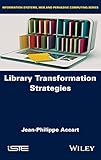Library transformation strategies / Jean-Philippe Accart.
By: Accart, Jean-Philippe [author.]
Language: English Publisher: London : Hoboken, NJ : ISTE Ltd ; John Wiley & Sons, Inc., 2022Copyright date: 2022Description: 1 online resource : illustrations (some color)Content type: text Media type: computer Carrier type: online resourceISBN: 9781786308870; 9781394173624; 1394173628; 9781394173648; 1394173644Subject(s): Library planningGenre/Form: Electronic books.DDC classification: 025.1 LOC classification: Z678 | .A33 2022Online resources: Full text is available at Wiley Online Library Click here to view| Item type | Current location | Home library | Call number | Status | Date due | Barcode | Item holds |
|---|---|---|---|---|---|---|---|
 EBOOK
EBOOK
|
COLLEGE LIBRARY | COLLEGE LIBRARY | 025.1 Ac221 2022 (Browse shelf) | Available | CL-51264 |
Browsing COLLEGE LIBRARY Shelves Close shelf browser
Includes bibliographical references and index.
Cover
Title Page
Copyright Page
Contents
Foreword
Introduction
Part 1. The Environment and Society
Chapter 1. Societal Changes and Libraries
1.1. In terms of innovation
1.2. In the working world
1.3. In the world of professional associations
Chapter 2. Economic Changes
2.1. An evolving documentary and information activity
2.2. The information economy
2.2.1. Some figures
2.2.2. Free information
2.2.3. An economic approach to information and libraries
2.3. Information as a public asset
2.3.1. Free of charge, information and public libraries
2.3.2. Why pay for information?
2.4. The Internet and digital technology
2.5. Towards new economic models
2.6. The theory of knowledge commons
Chapter 3. The Evolution of the Library Space
3.1. From the perspective of creation and innovation
3.2. From the third place to DIY
3.2.1. Digital public spaces (Espaces Publics Numériques, EPN) in France
3.2.2. Some examples of Fab Labs in American libraries
3.3. Learning spaces or learning centers
3.4. The Smart Libraries concept
3.5. Wellness spaces
3.6. Reception areas: a user-oriented approach
3.7. The use of the library space
3.8. Green libraries
Chapter 4. Legal Changes
4.1. GDPR: European data protection regulations, as applied to libraries
4.1.1. The fields of application
4.1.2. Data processing and hosting
4.2. Protection of personal data
Part 2. Human Resources and Management
Chapter 5. New Management Theories Applicable to Libraries
5.1. Participatory management
5.1.1. The five principles of participatory management
5.1.2. The qualities required for participatory management
5.2. Management by benevolence or well-treatment
5.3. Empathy, a management method?
5.4. Change management (CM). 5.4.1. The three levels of change management
5.5. Project management: theory and applications
5.5.1. Project mode operation: two case studies
Chapter 6. Some Theory on Management and Leadership
6.1. New management methods: Design Thinking, user experience and agile methods
6.1.1. Design Thinking
6.1.2. User experience (UX)
6.2. User power
6.3. Setting up and managing an agile project
6.3.1. The application of agile methods
6.3.2. Agility in libraries
6.4. Library management and leadership, constantly redefined concepts
Part 3. Library Tools and Technology
Chapter 7. The Digital Transformation of Libraries
7.1. The library as a service: from catalogues to digital platforms
7.1.1. Service platforms
7.1.2. Library intranets, information portals and digital repositories
7.1.3. Monitoring, business intelligence and curation platforms
7.1.4. Social platforms
7.2. Digital archiving of documents
7.2.1. Document archiving: an overview of open access
7.2.2. Dissemination methods
7.2.3. European Open Access Policy
Chapter 8. Other Technologies for Library Transformation
8.1. Blockchain
8.2. Augmented/virtual reality in libraries
8.2.1. A brief history of augmented reality
8.2.2. Augmented reality explained
8.3. Artificial intelligence (AI) and robotics
Part 4. Marketing
Chapter 9. Marketing Dimensions in Libraries
9.1. Digital marketing
9.2. The user at the heart of transformation
9.2.1. Addressing ongoing challenges
9.2.2. Capturing the user's attention online
9.3. Adopting a five-step marketing approach
9.4. Everyday marketing
Chapter 10. The User at the Heart: Mediation
10.1. Keeping in touch with the user: mediation
10.2. Mediation(s)
10.2.1. Library mediation
10.2.2. Social mediation
10.2.3. Cultural mediation. 10.2.4. Digital mediation
10.2.5. Scientific mediation
Chapter 11. The Library's Digital Identity
11.1. Defining identity
11.2. From the individual to the group and the library institution
11.3. Profiles, behavior and traces on the Internet
Chapter 12. Adopting a Library Branding Strategy
12.1. Defining the brand concept
12.2. Brands and libraries
12.3. The brand world
Conclusion
References
Index
EULA
Libraries continually focus on adaptation and adopt different transformation strategies to achieve this goal. These strategies demonstrate a clear desire to stay in tune with the times, while retaining the basic principles that underpin their day-to-day work and ensure they continue to exist. This book is a complete synthesis, a helpful resource for librarians and information professionals that develops four major strategies. The first focuses on understanding the environment and society, with organizational changes affecting cultural institutions (public or private), and the emergence of the library space. The second shows how management methods evolve within them (participatory approach, benevolence, empathy) with an emphasis on project management. The third strategy focuses on the integration of new library tools to better reach audiences. Finally, the fourth develops an essential and indispensable aspect of library marketing.






There are no comments for this item.